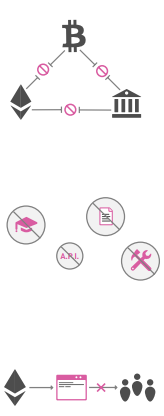We have already seen how projects like the Ferrum Network are proposing ways to fight the big issues that are arising with the increase in popularity that cryptocurrencies are experiencing, mainly scalability problems and the lack of interoperability between the major blockchains and cryptocurrencies.
But situations like this one tend to spawn more than one solution, and the very nature of blockchain technology allows for multiple companies offering different ways to fix these issues. Polkadot took the challenge and are now proposing a way to tackle it by distributing the transaction load among different parallel chains instead of creating proxy tokens to allow transactions between blockchains.
A deeper look into the problems
It is widely known that current technologies are starting to fall behind the demand of transactions they can validate per second if they aim to be implemented globally to the day-to-day routine of the average user, and the fact that currencies like Bitcoin and Ethereum, which make up more than 70% of the market, can’t communicate with each other only makes it even worse.
But the problem goes beyond that. The Polkadot team explains that this isolation among the big names in the market causes a lack of motivation for development of decentralized apps (DApps) because of the inability to reach the entire market, and thus there are not enough DApps to cover the users’ needs or motivate potential adopters to enter the crypto landscape. If a solution to the main issues of scalability and interoperability are solved or diminished, then the rest of the issues will also be reduced.
The proposed fix
What Polkadot proposes is a way to integrate big blockchains into a platform that allows for intercommunication of smart contracts and DApps, while also creating parallel blockchains (Parachains) for quick validation of more transactions per second than these blockchains could handle.
Their model is centered around a “Relay Chain”, which is the one that coordinates consensus and transactions between different Parachains, which are independent and gather and validate transactions from bigger blockchains through “Bridgechains”. This system is upkept by their role hierarchy: The Validators stake DOTs to secure the relay chain by validating the transactions they receive from the Collators, who are also in charge of reporting bad behavior to Validators. The Nominators are in charge of electing the validators by staking DOTs, and the Fishermen are a second line of security whose only responsibility is to monitor the network and report bad behavior.
The final stage
The team’s final vision is to create the Web3, which can “bring a completely decentralized world from theory to reality”. With Polkadot as its core, connections can be easily created between private institutional blockchains and public decentralized ones, making it simple to adopt ways of electronic payment. This could later motivate other technologies to be developed based on the Web3 for facilitated integration with existing blockchains, ease of data management and complete decentralization of user data.
It’s quite hard to predict which of these different visions to solve the scalability problem will be the one to hit the target, but more companies trying only increases the probability of the solution becoming real, which is a great necessity considering the problems only become larger by the day.



